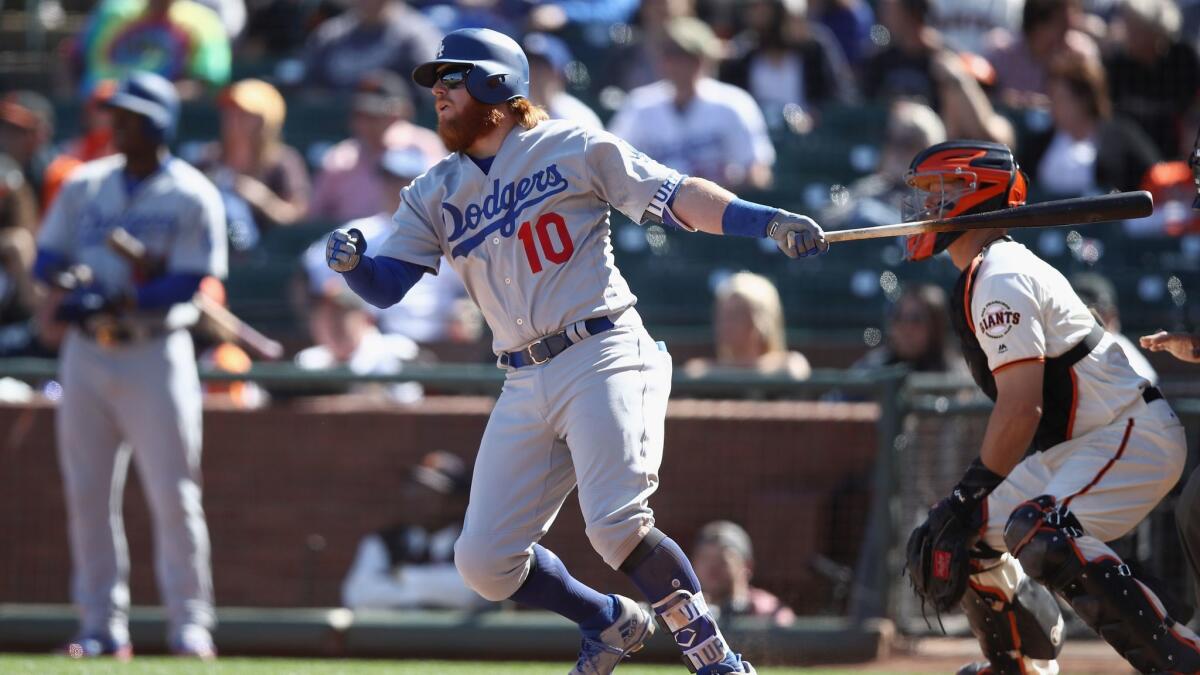Dodgers Dugout: How does the offense stack up to the NL? First base, center and right need help

- Share via
Hi, and welcome to another edition of Dodgers Dugout. My name is Houston Mitchell and I want to thank everyone who hasserved in the armed forces, as well as the families of those who lost loved ones who were fighting to protect our country.
The offense
With more than a quarter of the season finished, let’s take a look at how the Dodgers’ offense compares to the rest of the NL.
Runs per game
League average: 4.63
1. Washington, 5.72
2. Milwaukee, 5.11
3. Cincinnati, 5.09
4. Colorado, 5.08
5. Arizona, 5.06
6. New York, 5.04
7. Chicago, 5.02
8. Dodgers, 4.96
9. Atlanta, 4.62
10. St. Louis, 4.45
11. Philadelphia, 4.22
11. Miami, 4.22
13. Pittsburgh, 4.06
14. San Diego, 3.49
15. San Francisco, 3.39
Now let’s turn and take a look at WAR, which combines offense and defense. For a full explanation of WAR, go here. Again, all numbers are courtesy of baseball-reference.com.
For this section, we will look at where the Dodgers rank in the NL at WAR at each position. The top five at each position will be ranked, along with the Dodgers if they aren’t in the top five. Only the numbers put up while that player was at that position count. I will also list the last-place team at each position. Ties are broken by which team has the player at that position with the highest WAR rating.
Catcher
1. Dodgers (Grandal, Barnes), 1.7
2. Milwaukee, 1.3
3. San Francisco, 1.3
4. Atlanta, 1.3
5. Cincinnati, 1.0
15. San Diego, -0.5
First base
1. Arizona, 2.8
2. Atlanta, 2.6
3. Washington, 2.1
4. Cincinnati, 2.0
5. Milwaukee, 1.5
14. Dodgers (Gonzalez, Bellinger, Utley, Van Slyke, Segedin), -0.2
15. Philadelphia, -0.3
Second base
1. Philadelphia, 1.4
2. Chicago, 1.0
3. Dodgers (Taylor, Forsythe, Utley, Hernandez, Barnes), 1.0
4. Colorado, 0.9
5. St. Louis, 0.8
15. San Diego, -0.5
Third base
1. Dodgers (Turner, Forsythe, Taylor, Hernandez), 2.5
2. Cincinnati, 2.4
3. Colorado, 2.3
4. Washington, 1.9
5. Chicago, 1.9
15. San Francisco, -0.8
Shortstop
1. Cincinnati, 2.2
2. Dodgers (Seager, Hernandez, Taylor), 1.3
3. Chicago, 1.1
4. Arizona, 1.0
5. Milwaukee, 0.8
15. New York, -0.6
Left field
1. New York, 1.8
2. Miami, 1.5
3. Philadelphia, 1.1
4. Dodgers (Bellinger, Toles, Gutierrez, Van Slyke, Hernandez, Eibner), 1.0
5. Cincinnati, 0.7
15. San Francisco, -1.2
Center field
1. Colorado, 1.2
2. Chicago, 0.9
3. Arizona, 0.7
4. Miami, 0.7
5. Atlanta, 0.7
13. Dodgers (Pederson, Hernandez, Toles, Thompson, Eibner, Taylor), -0.2
15. San Francisco, -1.2
Right field
1. Washington, 2.4
2. Arizona, 1.6
3. Chicago, 1.5
4. Cincinnati, 0.7
5. New York, 0.7
8. Dodgers (Puig, Hernandez, Eibner, Van Slyke, Bellinger), 0.3
15. Pittsburgh, -0.8
Pinch-hitter
1. Milwaukee, 0.7
2. Dodgers, 0.7
3. Arizona, 0.6
4. New York. 0.5
5. Chicago, 0.5
15. San Francisco, -0.8
There’s nothing terribly surprising here. L.A.’s biggest weak spots are first base, center field and right field. Justin Turner remains almost criminally underrated nationally.
Record
When the Dodgers lost to the Giants on April 26, they fell to 10-12, four games behind Colorado in third place in the NL West.
Since then, they have gone 18-8, the best record in baseball, but are still in third place, 2 1/2 games behind Colorado, who have gone 17-10 in that time, the fourth-best record in baseball.
Stop playing good teams
The Dodgers’ record this year against teams with a losing record: 18-8
The Dodgers’ record this year against teams with a winning record: 10-12
Comparison
The Dodgers are trying to win their fifth consecutive division title. Let’s take a look at this year’s record and how it compares through the same point the last four seasons.
2017: 28-20, third place, 2 1/2 games behind Colorado
2016: 25-23, second place, 4 1/2 games behind San Francisco
2015: 29-19, first place, half a game ahead of San Francisco
2014: 25-23, third place, five games behind San Francisco
2013: 20-28, fifth place, seven games behind San Francisco and Arizona
Ask Ross Porter
Once again, former Dodgers announcer Ross Porter is back to answer select reader questions. Email me a question for Ross, and I will pass it on. Here’s this week’s answer:
Dave Kiffer asks: “Ross, we all remember Dodger pitchers like Koufax, Drysdale, Valenzuela and Sutton, but statistically who do you think has fallen the farthest off the radar? Which pitcher in L.A. Dodgers history do you think doesn’t get enough credit?”
Ross: The first name that comes to my mind, Dave, is Eric Gagne, who pitched for the Dodgers from 1999 to 2006. He set major league records when he converted 84 consecutive save opportunities and 51 straight at home between 2003 and 2004.
In 2003, Eric won the Cy Young Award when he appeared in 77 games, registered 55 saves to tie John Smoltz‘s National League record, and allowed only 37 hits. He struck out 100 batters, walked 20, and allowed just 11 earned runs.
Ironically, Eric retired from baseball last Sunday at the age of 41 after pitching for the Independent League Long Island Ducks.
For the man remembered for the phrase, “Game Over,” it now is.
Next series
Friday, 7 p.m. PT, Chicago (Jake Arrieta, 5-3, 4.80) at Dodgers (Alex Wood, 5-0, 1.88)
Saturday, 4 p.m. PT, Chicago (John Lackey, 4-4, 4.82) at Dodgers (Brandon McCarthy, 4-1, 3.76)
Sunday, 1 p.m. PT, Chicago (Jon Lester, 3-2, 3.19) at Dodgers (Clayton Kershaw, 7-2, 2.01)
And finally…
Homer Simpson is inducted into the Baseball Hall of Fame. Read all about it here.
Have a comment or something you’d like to see in a future Dodgers newsletter? Email me and follow me on Twitter:@latimeshouston.
Twitter: @latimeshouston
More to Read
Are you a true-blue fan?
Get our Dodgers Dugout newsletter for insights, news and much more.
You may occasionally receive promotional content from the Los Angeles Times.










